Celebrating A Rich Avian Heritage: Jammu & Kashmir Bird Festival
First published in Sanctuary Asia,
Vol. 42
No. 12,
December 2022
by Shatakshi Gawade and Francesca Cotta
Autumn made its graceful presence known in the shy incandescence of yellows and oranges in the chinars, the plumpening apples clearly visible through fenced orchards along the highway and in the crisp, cold air that gave a welcome respite from a hearty sun. We were an unconventional group of ornithologists, birders, conservationists and hospitality students, making our way towards the Pahalgam Club and Convention Centre for the inauguration of Jammu and Kashmir’s (J&K) first ever bird festival, held on October 6-8, organised by the Department of Tourism, J&K in collaboration with the Sanctuary Nature Foundation (SNF), and supported by the Bombay Natural History Society (BNHS) and the Wildlife Conservation Fund (WCF), Pampore as partners.
The Sanctuary Nature Foundation has been working in the union territory for the past four decades and our readers are aware of how much we value the avian riches of both, Jammu and Kashmir. Launching a bird festival in this biodiversity-laden, geographically unique union territory has been an important agenda for us, for the past four or five years. With over 550 species of birds, many of which are rare or endemic to the region, it’s a wonder that J&K had not had its own bird festival yet, when so many other states across the country regularly organise them. We are delighted to have had a part to play in changing that fact.'
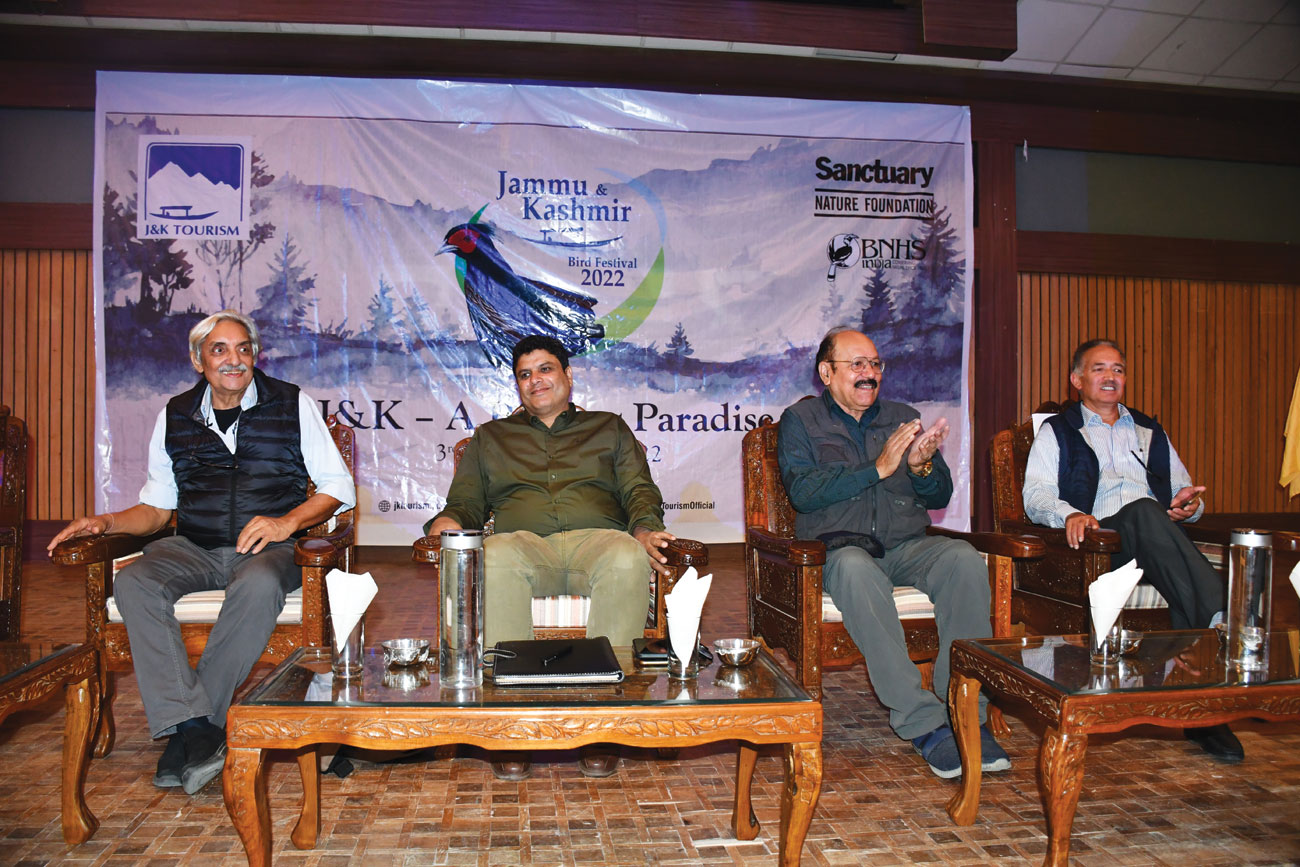
The Chief Guest Sarmad Hafeez, Secretary of Tourism, was joined on stage by other dignitaries such as Dr. Asad Rahmani, conservationist and former Director of BNHS, Bittu Sahgal, Founder of Sanctuary Nature Foundation, and Farooq Gillani, retired additional principal Chief Conservator of Forests (Kashmir). Photo Courtesy: Dr. Bilal Nasir Zargar.
A Gold Mine Of Potential
For Sanctuary’s Founding Editor, Bittu Sahgal, the logic is crystal clear: J&K is undoubtedly among the best, and probably the least discovered, birding destinations in the world. As Dr. Asad Rahmani, ex-Director of the BNHS, said at the festival inauguration, “We are sitting on a gold mine.” Without a shadow of doubt, avians are the most visible and attractive indicator species of the health of the ecosystems in which they live. The people who live closest to wildernesses are the ones who know it best. They also stand to benefit the most from activities that safeguard their forests – both in terms of well-being and livelihood. The idea in organising this festival was to bring some of the country’s finest ornithologists and birders under the same roof – or canopy! – as J&K’s youth, particularly those passionate about birding. The birding sessions, workshops and talks held at this year’s event were just the beginning of what will be a long-term project of building capacity in the local youth to become trained bird and nature guides, so that they may generate an adequate income from doing this.
With this vision as the backbone of J&K’s first bird festival, we were thrilled that the Department of Tourism, J&K, was a co-organiser. Dr. Deeba Khalid Peer, ensured full support from the Department of Tourism, Kashmir, to set a strong foundation for the J&K Bird Festival, 2022 as a vibrant platform for birdwatchers around the country.
Dr. Bivash Pandav, Director, BNHS, also echoed the opinion that the bird festival becomes a baseline initiative to improve the birding skills of local youth, particularly from rural areas. He pointed out that given how many people generate an income from taking people birdwatching, there would be a high demand for the same in J&K, which has a tremendous variety of birds. He hopes that in the future, that tourists come to Dachigam not just to see the black bear and hangul but also for the 40-50 species of birds they can encounter there.
Another motivation for organising this festival is to promote lesser-known birding hotspots, such as in Jammu – where Sanctuary plans to do a bird festival in the near future – and Dara, adjacent to Dachigam, in whose valleys there is potential to bring similar forests back.
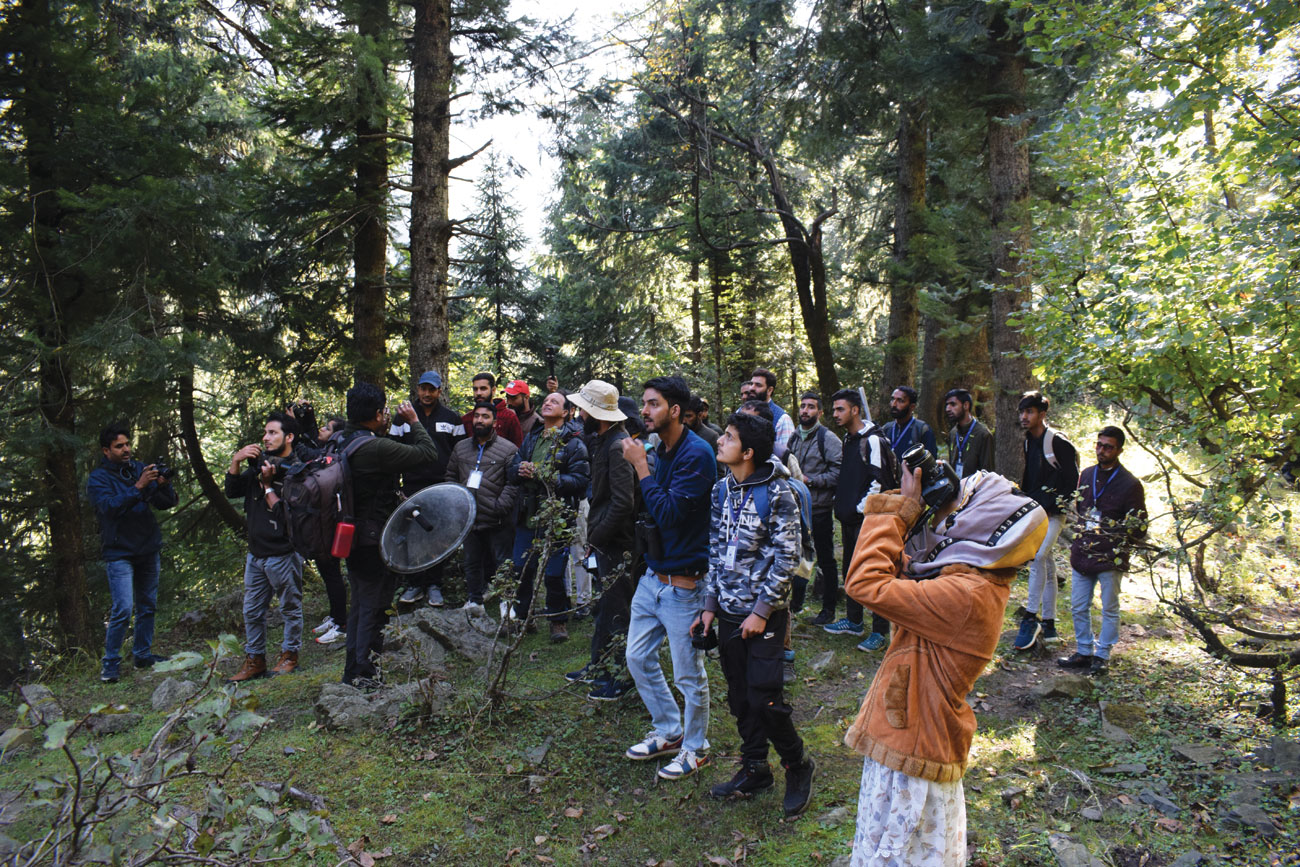
As part of the J&K Bird Festival 2022, participants hiked in the Overa-Aru Wildlife Sanctuary for an early morning birdwatching session with experienced birdwatchers and photographers. Dr. Asad Rahmani, highlighted an unusual fact about the forest – eight species of warblers breed in the Overa Aru Wildlife Sanctuary, making it important scientifically, and truly a birdwatchers’ heaven. Photo Courtesy: Dr. Bilal Nasir Zargar.
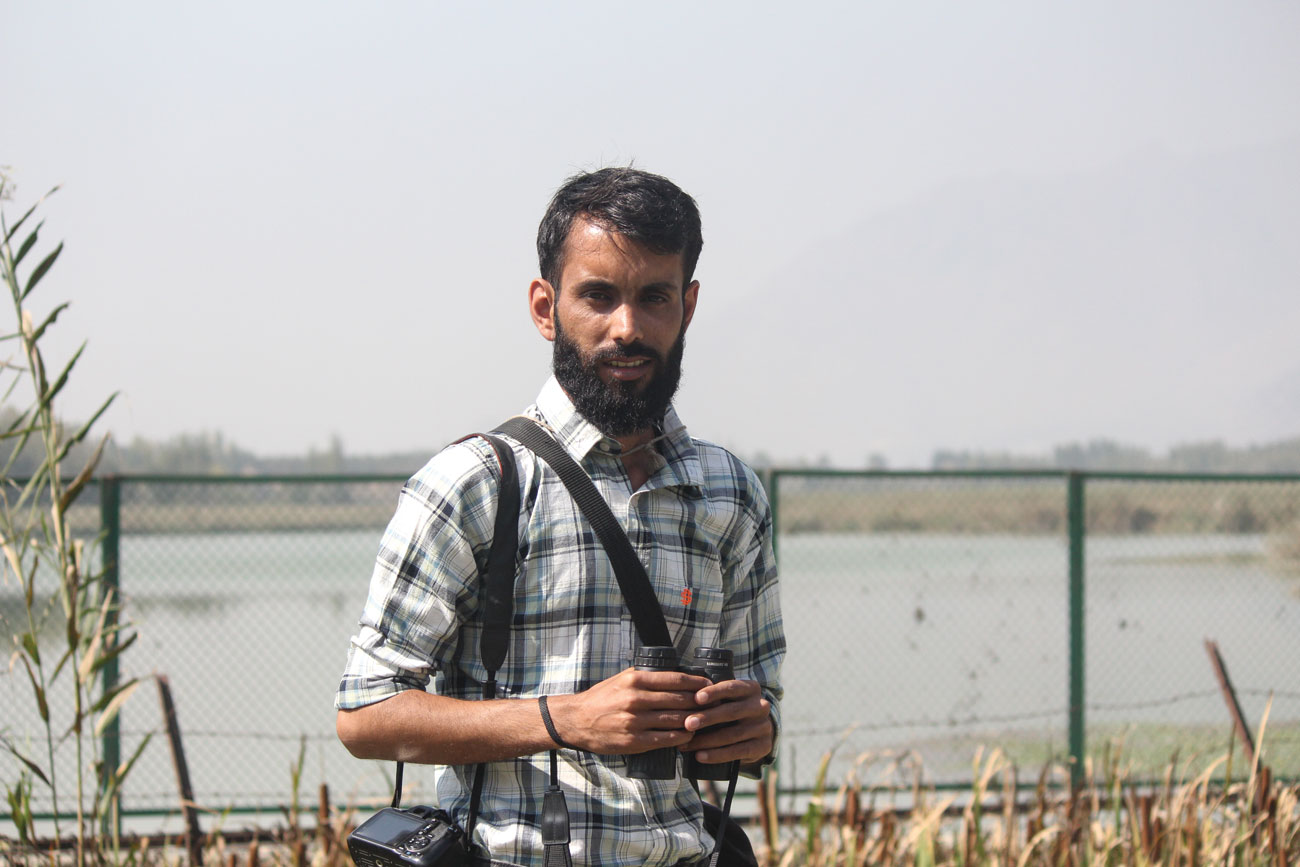 Photo: Prachi Galange.
Mohammad Ayoub Nayiak and Aijaz Ul Gani: The young men who trekked 40 km. to reach the Bird Festival!
Photo: Prachi Galange.
Mohammad Ayoub Nayiak and Aijaz Ul Gani: The young men who trekked 40 km. to reach the Bird Festival!
Ayoub, an agriculture assistant manager, and Aijaz, his cousin, walked for a day for over 40 km. to reach the Bird Festival, all for their love of birding. “We walked so that we could explore the landscape and birds along the route,” Ayoub shared. Their route brought them from their village Reasi, Jammu district via Gulabgarh, Nikan, Zajimarg, Nandimarg, Damal Hanjipura and Kulgam to Pahalgam. Ayoub is an avid birder. He shared that he is the second person to have recorded the presence of the Dark-side Bush Warbler, in 2019; the first record was in 1971! “I was introduced to birding by my college professor. Nadeem Qadri (Founder, WCF) who has constantly motivated me to continue birding,” said Ayoub. During their long trek to reach the Bird Festival, Ayoub and Aijaz spotted the Himalayan Monal and Blue Rock Thrush, among a host of other birds and butterflies.
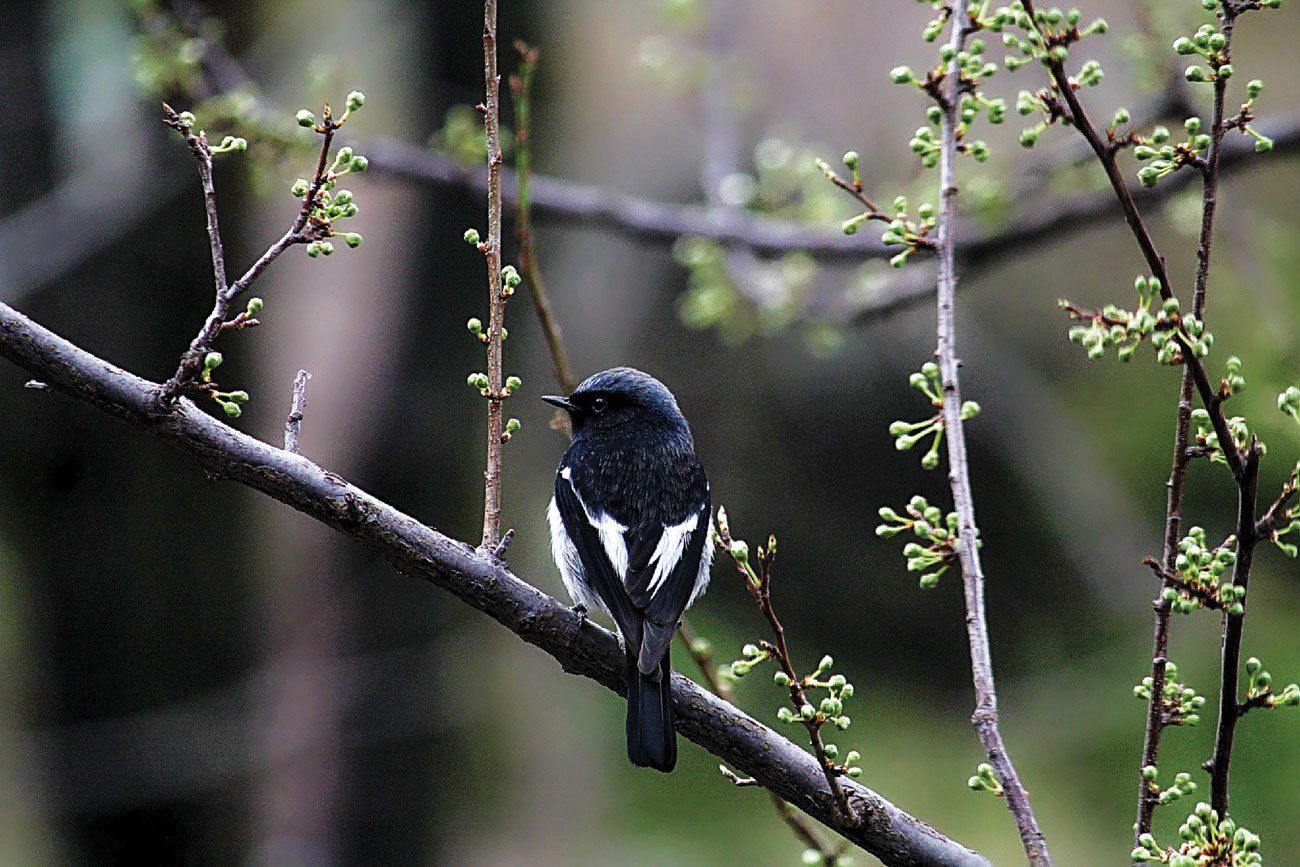
Photo: Mohammad Ayoub Nayiak
Setting Hopeful Intentions
The inaugural event, held at the Pahalgam Convention Centre along the sparkling, glacial Lidder river, helped us orient ourselves within the intentions for the festival. In his opening address to the audience, Sarmad Hafeez, Secretary of Tourism, Government of J&K said, “This festival will help invite people from across the country and the world to visit our beautiful region for birdwatching and nature.” The collaboration between the Department of Tourism and SNF was officiated in the signing of a memorandum of understanding between the two. Later, Dr. Asad Rahmani gave an insightful presentation on the birds of Kashmir, and stressed upon the importance of using such festivals as platforms to raise awareness on the conservation issues faced by the region’s most vulnerable Important Bird Areas (IBAs). He spoke about how many of Kashmir’s wetlands were in important need of attention and should come under the purview of future festivals.
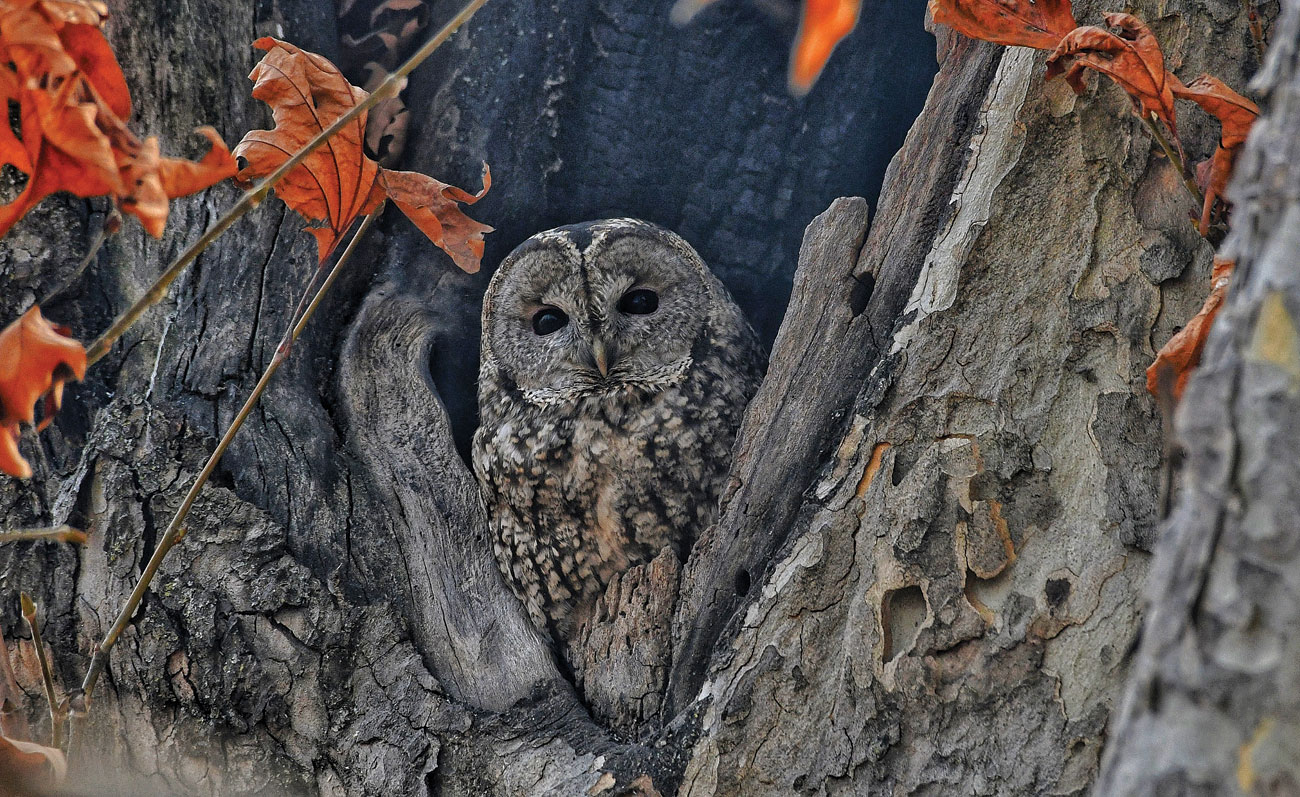
Jammu and Kashmir offers over 550 avian species for birders to test their patience and skill including beautifully camouflaged birds like this Tawny Owl Strix aluco. Photo: Rouf Ahmad Rather.
Early Birds
The second and third days of the festival happily began with a morning bird walk. The first one was at the Overa Aru Wildlife Sanctuary, named after the neighbouring village and stream. Intesar Sohail, Wildlife Warden, Shopian and co-founder of Kashmir Birdwatch, shared that the sanctuary was earlier a game reserve for royalty, mainly for the endemic hangul. A wooden cabin at the entry of the sanctuary now functions as a pitstop for hikers. Dr. Rahmani highlighted an unusual fact about the forest – eight species of sympatric warblers breed in the sanctuary, only the second other place in the world where this happens. Some of the rarer birds that also breed here are the Kashmir Flycatcher and the Ibisbil. Perhaps rarer than the birds sighted that morning was the presence of so many skilled and seasoned birders in one place! They formed a veritable ‘parliament of pros’, and the other attendees thoroughly enjoyed the chance to watch and listen to them spot and correctly identify birds, and share their natural history details.
As we walked, every now and then, we would hear the call of a bird or see a flutter of its wings and the group would slow its pace and tread more quietly than before. Binoculars would be held up, sometimes passed around, camera lenses focused, and the occasional excited murmur would float through the crisp air as one human or the other in our group had their first encounter with a particular species of bird. Dr. Parvish Pandya, SNF shared precious information about bird adaptations and behaviour, while Saurabh Sawant, SNF rattled off the names of species seen with their habitat preferences and conservation.
By the end of our morning, we had spotted or heard the Slaty Blue flycatcher, Himalayan Woodpecker, Lemon-rumped Warbler, Coal Tit, Yellow-billed Blue Magpie, Little Forktail, White-capped Water Redstart, Brown Dipper, Himalayan Bluetail, Plumbeous Water Redstart, Cinereous Tit, Bar-tailed Treecreeper, Whistler’s Warbler, Grey Bushchat, Large-billed Crow, Black-eared Kite, Blue Whistling Thrush and Spotted Forktail. Back at the wooden lodge at the entrance of the sanctuary, with the mid-morning sun warming our backs, we sipped on cups of hot kahwa at the former hunting lodge, chattering as merrily as the birds in the forest.
The next morning, the group went to Pampore to see the wetland birds, along with students from Satisar Educational Institute, a school in the area. As we shuffled past what looked like barren fields, we began to notice tiny flashes of purple poking through the soil at some points – early blooming saffron flowers! Pampore has four wetlands – Fashkoori, Chatlam, Kranchu and Mainbug. They form an interconnected complex, which supports a rich variety of resident and migratory bird life of at least 137 species. That day, we spotted mallards, the Common Moorhen, Common Coot, Grey-headed Swamphen, Common Kingfisher, White-breasted Kingfisher, Little Grebe, House Sparrow, Common Myna and Grey Wagtail.
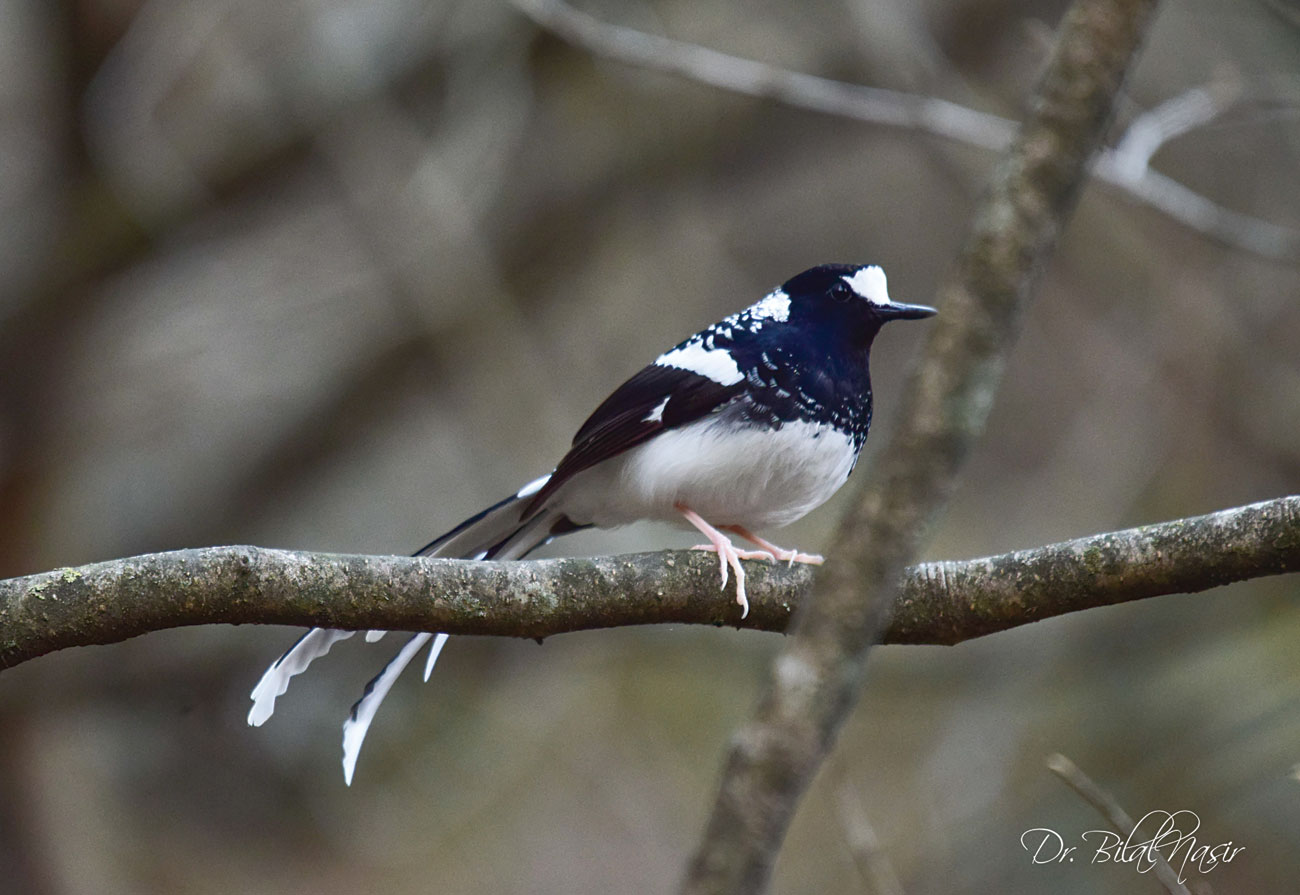
Spotted Forktail Enicurus maculatus. Photo Courtesy: Dr. Bilal Nasir Zargar.
J&K has over 3,000 wetlands, but these nutrient-rich ecosystems are threatened on account of anthropogenic pressures such as dumping of polluted water and solid waste. Advocate Nadeem Qadri and his dedicated band of volunteers from WCF, have been working tirelessly on raising awareness in the community that lives around the Pampore wetlands and helped work behind the scenes to make the bird festival possible.
The day’s events also included a photo exhibition of the birds of Kashmir, set up near the Chatlam Wetland, and was attended by local school students, along with the Forest Department, Fisheries Department, Wildlife Department, team members of SNF and BNHS, experienced birders and photographers, and various volunteers of WCF. Bittu Sahgal also addressed the frontline staff of the Forest Department and commended them for their efforts in protecting the wetlands.
Professor G.M. Bhat, a geology expert and Chief Advisor, The Nature University, Pampore spoke poetically of these rich habitats, “The wetlands of Pampore tehsil are a time capsule – the sediments under these wetlands are a repository of the climate history of thousands of years. They are a sinkhole for carbon dioxide and home to a variety of bird species. We need to preserve and protect these wetlands.”
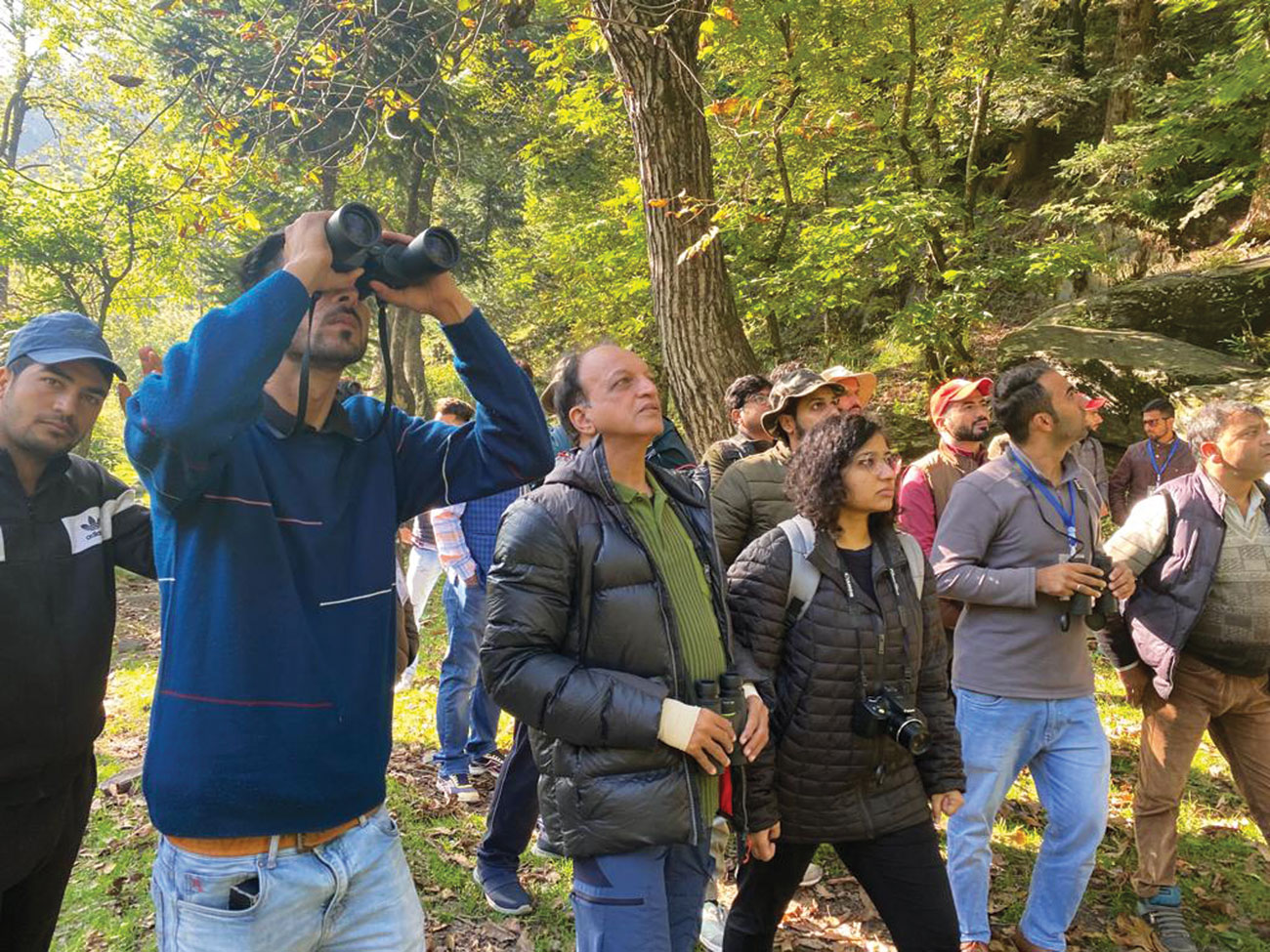 Photo Courtesy: Dr. Bilal Nasir Zargar.
Parvaiz Yousuf: a lifelong birder with a passion for learning
Photo Courtesy: Dr. Bilal Nasir Zargar.
Parvaiz Yousuf: a lifelong birder with a passion for learning
Parvaiz has completed his Masters in Zoology from the Central University of Kashmir and is currently applying for a Ph.D. He says birding is a hobby, one he is passionate about and glad to be able to do anywhere he goes. He was one of the WCF volunteers, who helped in many aspects of putting together the festival. For him, the highlight of the event was meeting different experts and getting more birding experience from them.
Parvaiz has loved birds all his life. His home is just a hop, skip and jump away from the bank of the Chatlam Wetland Reserve. As a child, whenever I would open a window in my house, he would see a variety of birds. As he grew older, he met some expert birders and became curious about the activity. By 2020, already a birder, he attended a Green Skill Development programme organised by the Central Ministry, which helped him improve his understanding of the basics.
Always keen to learn new things, visit new places and find new birds, Parvaiz is pleased to have seen rare species such as Orange Bullfinch, bramblings, Yellowhammer, Tawny Owl, Kashmir Nutcracker and Kashmir Nuthatch – only found in J&K.
In the future, he hopes that many youth will visit these birding hotspots in the union territory, and learn more about birds. He is keen to share their knowledge with them, and introduce them to the hundreds of bird species found in Jammu, Kashmir and Ladakh. He also really wants that the four wetlands of Pampore to be declared as Ramsar sites, as they fulfill all the criteria.
Transferring Knowledge
Some of the most valuable interactions between young festival volunteers and attendees from J&K and some of the finest birders and ornithologists in the country took place on the second day.
The BNHS’ Dr. Madhumita Panigrahi and Dr. Mrugank Prabhu gave a detailed presentation on the process of bird ringing for research purposes, along with a display of different equipment such as pliers, rings and nets. They spoke of the precautions needed during ringing and the different methods that can be used. We listened in fascination to her insights about the different temperaments of birds, and what one may expect while ringing them. We laughed when Dr. Panigrahi told us that Ruddy Shelducks are strong and can drag you while being ringed, but began to wince when she spoke about Shrikes – known as butchers – that can dig into your skin and pull a chunk of it out. They ended their talk by explaining how bird photographers could share information with the BNHS of ringed birds they spot, explaining that data collected through ringing can be used to study various aspects of birdlife. These links established between hardcore scientists and citizen scientists are precisely the reason why events like this bird festival are much needed!
Megh Roy Choudhury, a brilliant wildlife photographer and a Canon EOS Explorer also conducted a spirited presentation on ‘How to be a better wildlife photographer’. She spoke of photographing for the love of wildlife and nature and not for social media. Through various examples of her own stunning images, she generously shared the techniques she uses to make images, and shared many tips with photographers and birders on how to get the best images while not disturbing wildlife. She spoke about how photography should not just be for photography’s sake, but should be used for conservation.
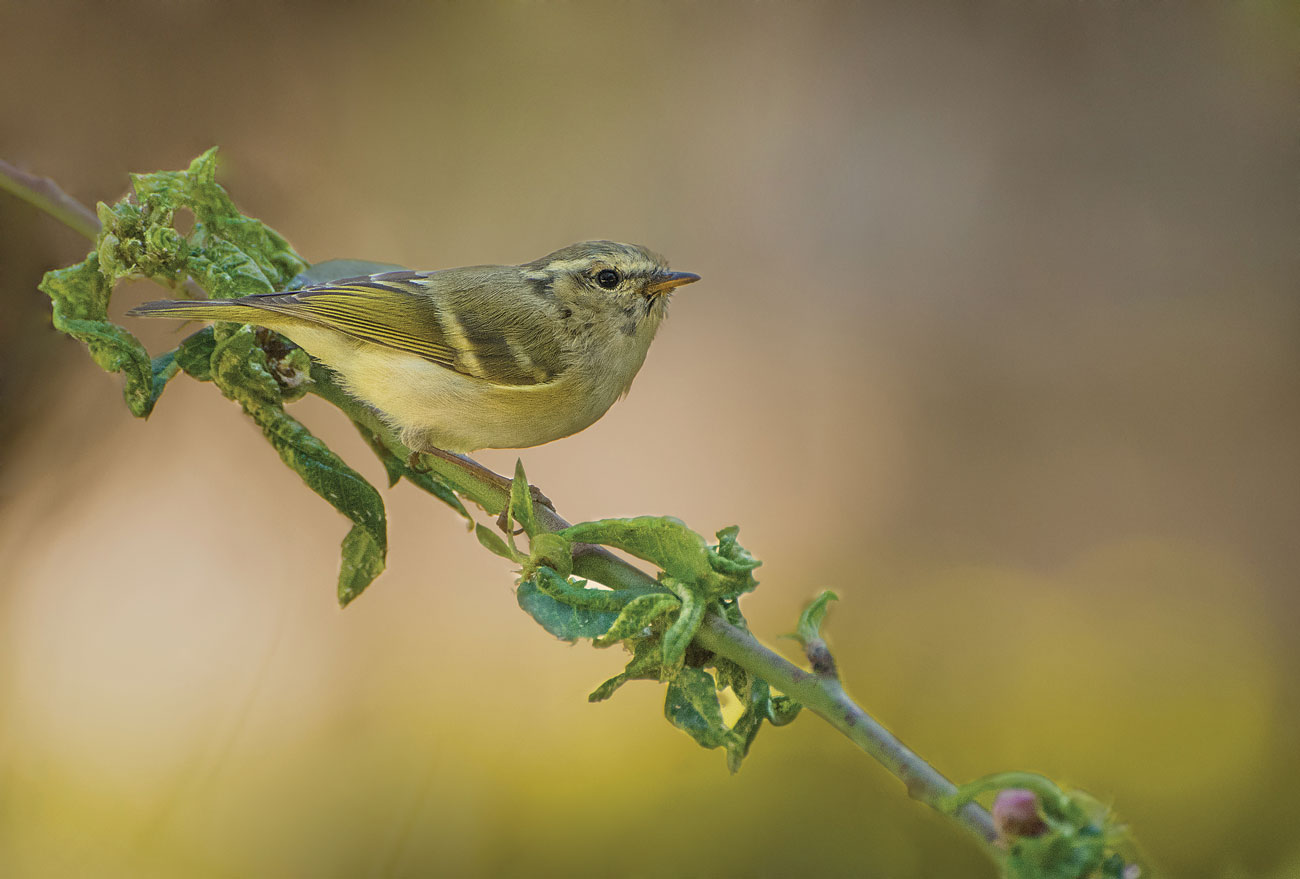
Lemon-rumped Warbler Phylloscopus chloronotus. Photo: Parvez Shagoo.
This first edition of the J&K Bird Festival laid the foundation for what will be an annual event where expert ornithologists from within J&K and other parts of the country, meet and interact with keen birders and nature lovers, and share their experience and expertise with them. The idea is for new vistas for birding, trekking and camping to open up in the union territory, at the intersection of conservation, hospitality and education.
We parted ways after an invigorating three days, certain that we had only just begun to scratch the surface of this abundant avian paradise.









